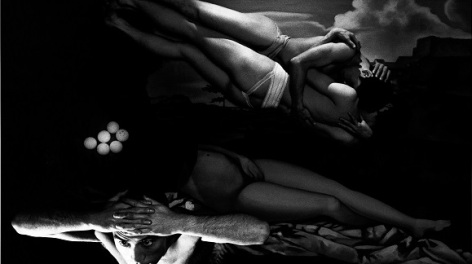Metamorphosis of Japan After the War
22 January - 26 April 2015
These two decades constituted a period truly brimming with creative energy – a time in which democracy led to the restoration of vitality and free photographic expression, in which new talent pioneered post-war photography.
This new exhibition reflects on the turbulent period that followed the war, exhibiting over 100 black and white photographs by 11 leading post-war Japanese photographers, including Yasuhiro Ishimoto, Shomei Tomatsu, Eikoh Hosoe and Ken Domon. Rather than arranging the works by period and author, this exhibition is divided into three sections – “The Aftermath of the War,” “Between Tradition and Modernity,” and “Towards a New Japan.”
Although the arrangement may seem arbitrary, the sequence provides a vivid narrative of the convoluted aspects of this complicated era.
The exhibition is organised by The Japan Foundation
The minimalist space, with its whitewashed walls and
concrete floor, provides a backdrop for some exhibition spaces of contemporary
photography, promoting the belief that photographs are the most powerful means
by which to explore ‘the lives of the contemporary world, the living cultures
of different territories and the inspirations from various ideologies. For the
people involved with The Open Eye, photography is more than a mere medium; it’s
also visual language, a form of narrative that can open up new possibilities in
contemporary culture. Exhibitions like “Metamorphosis of Japan after the War” by
11 well-known post-war photographers
including Yasuhiro Ishimoto, Shomei Tomatsu, Eikoh Hosoe and Ken Domon.
The exhibition has opened up such possibilities, turning images of traditional
Japanese failed feudal fiefdom to industrial powerhouse revolution by
portraying the photographs as ghostly metaphors for Japanese identity in flux.
The
exhibition is divided into three sections; the aftermath of the war, between
tradition and modernity, and towards a new Japan. Although the arrangement may seem arbitrary, the
sequence provides a vivid narrative of the convoluted aspects of this
complicated era. “In
less than two decades, Japan went from a crushing military defeat to
establishing itself as a rising economic superpower,” says co-curator Marc Feustel.
The exhibition design for this display is clearly
chronological. The flexibility of removing the exhibitions is effective in
terms of the works that are displayed and to that of the curating team, by
using sticky labels as artist’s statements underneath the displays makes it
easier for the exhibitions in the Open Eye to change without making it
difficult on redecorating the gallery space. One downside I found when visiting
the gallery was that it lacked visual impairment for the older audiences to
communicate with the displays, an example of this would be the height of the
work presented in the main gallery area by the foyer. The lighting makes it
difficult to see the top row of photographs on the main wall too. The positive
outlook on this small remark is that the statements of the photographs are
situated on the right hand side of the wall where they are presented, this
makes it easier for the audience as a Title of the work can give a hint what
the work is about. However, I noticed that the font size of the statements are
also small given that they use the repetitive styled font for all their artwork
displays.
The artwork displayed in the gallery area 1 are set in portrait
and some in landscape this is due to the size of the photograph being taken and
in the order of the rise in the publishing business that was happening in Japan
during the late 1940’s, the curator suggested that the borders in landscape
show the revival of human spirit progressing onto the portrait frames showing
industrialization lifestyle during the war. The frames protecting the
photographs were chosen to follow suit to the monochrome interior to the
gallery and to that of the black and white photographs. This gives a sense of
negative space because of the already white walls and concrete floor it makes
the viewer aware like myself to understand the change in the gallery itself as
well as the topic of the exhibition. Some portfolios of photographs and magazines
of that time are kept in glass cabinets set in the middle of the room,
obviously being a part of the exhibition but are inaccessible to the public for
handling for conservation care.
Review: 20/03/2015

No comments:
Post a Comment